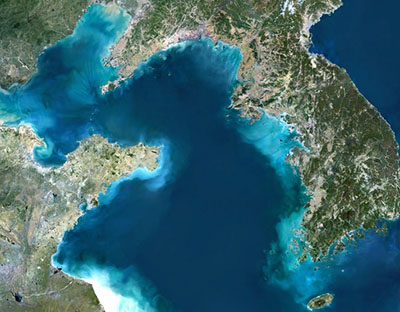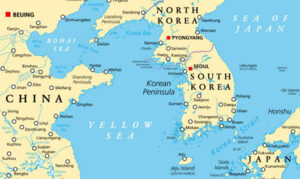by WorldTribune Staff, June 18, 2023
The violent April 3, 1948 attack by communists on the Korean island of Jeju was part of a larger insurgency to disrupt the UN-supervised elections and was not the “democracy struggle” that the leftist South Korean Democratic Party of Korea insists it was, a report said.
The Democratic Party of Korea (Deobureo Minju Party) went so far as to introduce a bill in March mandating that citizens refer to the insurgency leading up to the invasion from the North and the outbreak of the Korean War only as a “democracy struggle,” with punishments of up to five years in prison.

“Communist guerrillas went on a rampage, killing police officers, election workers, and others; setting houses on fire; and terrorizing villagers, all to discourage them from voting in the upcoming May 10 elections that would establish the Republic of Korea (ROK),” Tara O wrote in a June 13 analysis for the Hudson Institute.
The insurgency — referred to as Jeju 4.3 — “triggered a government counterinsurgency, forcing the communists into the mountains where they would continue their guerrilla operations for nine more years,” the analysis said.
Jeju is the largest island in what Koreans call NamHae, or the “South Sea.”
“When Korean students and workers returned to the island from Japan, China, and Manchuria after the end of World War II, its population ballooned from 220,000 to 280,000. Many of these returning Koreans were exposed to or participated in communist movements abroad. Soon after Korea’s liberation, the KWP-S and its various subsidiaries and affiliate organizations were widely influential in Jeju,” Tara O noted.
Pak Hon-Yong, also known as the “Lenin of Chosun,” would take over the communist party in Korea — initially named the Chosun Communist Party and later reorganized and renamed as NamNoDang or the Korean Workers’ Party-South (KWP-S) — from its initial leader, Yo Un-Hyong.
 “Both Yo and Pak were long-time communists, trained in Moscow at the invitation of Vladimir Lenin. They envisioned a socialist Korea led by a communist party,” Taro O noted.
“Both Yo and Pak were long-time communists, trained in Moscow at the invitation of Vladimir Lenin. They envisioned a socialist Korea led by a communist party,” Taro O noted.
Korea was liberated from the Japanese in World War II, but the United States arrival at Jeju was late and “gave communists more time than in the rest of Korea to expand their influence.”
From Japan’s surrender on August 15, 1945, until at least early 1946, Jeju was administered and controlled by people’s committees under the communist party and the illegal People’s Republic of Korea.
After initially tolerating the communist party, the U.S. Army Military Government in Korea (USAMGIK) issued a warrant for Pak in late 1946. Pak fled north of the thirty-eighth parallel but continued directing the party’s efforts to undermine stability in southern Korea.
Some 60- to 70,000 residents of Jeju joined island branch of the KWP-S and they were armed with the weapons left behind by 58,000 Japanese soldiers.
“The KWP-S planned extensively to create as much terror as possible by attacking and killing the police, those who supported the soon-to-emerge ROK, and those involved in the elections — as well as their families. According to the KWP-S’s report after the rebellion, the planning phase lasted from March 15 to April 2, 1948. The fact that it could prepare so quickly indicates that there was already a well-organized, structured, and active force from which the KWP-S could quickly draw personnel, intelligence, and resources,” Tara O noted.
The analysis continued: “At the top of the KWP-S was the Central Committee, which sent instructions to its next lower-level organization, in this case the South Jeolla Committee, which in turn conveyed the instructions to its next lower-level organization, which in this case was the Jeju Committee. In mid-March 1948, the South Jeolla branch of the KWP-S gave the Jeju branch very specific orders to prepare for the assault: it was to establish a military committee to serve as a command organization; create an insurgent organization (jawidae) of 200 partisans to support the armed attacks; equip the guerrillas with weapons and supplies; and strengthen its propaganda push ahead of the event.”
The attack on Jeju “was not a random civilian ‘struggle,’ but a carefully planned paramilitary operation to achieve the political objectives of the KWP-S, under the direction of Pak Hon-Yong in collaboration with Kim Il-Sung and the occupying Soviet Red Army,” Taro O noted. “With foreign and domestic political support, a centralized command structure, and military-grade weapons, the KWP-S insurgents were prepared to wage their irregular warfare campaign on the still-forming Republic of Korea.”
On April 3, 1948, between 1 a.m. and 2 a.m., the KWP-S operatives “lit beacon fires in the lower hills surrounding Mount Halla to signal the beginning of the assault. About 350 armed guerrillas — 30 with small arms and 320 with metal and bamboo spears — simultaneously attacked 12 police stations, killed police officers, and, starting at 2:00 a.m., stole weapons, according to the KWP-S guerrilla unit document,” the analysis continued.
They also attacked the sleeping quarters and residences of the police, government officials, and Seochong youths who had fled Soviet communist oppression in northern Korea. The guerrillas killed entire families and burnt their houses.
The village of Gu-eom uffered the greatest damage on the first night of attacks. About 100 communist partisan rebels were divided into four to five teams and went door to door for three hours to seek out and brutally murder their targets, before setting the victims’ houses on fire. In Gu-eom, five family members were killed, about 10 family members were injured, and one policeman was seriously wounded. Two armed rebels were also killed.
Firsthand accounts detailed the initial wave of attacks in various towns on Jeju Island:
• Communist guerrillas stabbed Sin-eom substation policeman Song Won-ha eight times with swords and bamboo spears. He barely escaped death, but his father died after guerrillas attacked him. At a Namwon police substation, assisting member Bang Sung-hwa was instantly killed; Kim Seok-Hoon’s arm was cut off with an axe; policeman Ko Il-Soo’s throat was cut and was killed; and Bang Sung-eon was injured. Theguerillas seized firearms and bullets from the weapons armory and fled.
• About 100 guerrillas ambushed the home of Moon Young-Baek, a figure on the political right, in the village Gu-eom, but Moon already fled and was not there. Communist guerrillas killed Moon’s 14-year-old daughter Moon Suk-ja and 10-year-old daughter Moon Jung-ja by stabbing them with bamboo spears as they pleaded for their lives. Mun Ki-chan, who lived in the same village, was also stabbed to death with bamboo spears, and Moon Yong-joon was stabbed with bamboo spears and died a few days later. In addition, guerrillas beat the pregnant wife of Ko Chil-Gun with clubs, injuring her, and stabbed 34-year-old Moon Chang-Soon to death.
• On April 4, 1948, guerrillas killed 36-year-old Oh Seung-Jo, a member of the Korean Youth Corps (Daecheong), a youth group on the right, at Yeonpyeong village. On April 6, guerrillas killed 37-year-old Yi Ho-Ri and 32-year-old Yang Nam-Ho, the leader and a member, respectively, of the Korean Youth Corps, while saying, “Don’t participate in the May 10 elections.”
By the end of the first wave of attacks, the KWP-S had killed 10 policemen and 17 civilians, injured eight more, and taken five hostages. Four guerrillas were also killed, according to the KWP-S’s report. The rampage was only the beginning of a much larger communist guerrilla insurgency.
“The KWP-S would go on to hold Jeju Island, using fear to control the population, until late July 1948,” Tara O noted.
During this period, the communists’ reign of terror and brutal killings included:
• Insurgents buried alive Pastor Yi Do-Jung, the first Christian pastor born on Jeju Island. He was murdered on June 18, 1948, according to Yi Dong-Hae, the pastor’s grandson.
• Kang Hak-Song, a resident of Namwon-eup, testified that his father, who was the supervisor of those guarding his village, was kidnapped when the KWP-S attacked his village. Kang later found his father’s body covered in blood and in pieces, with his limbs dismembered from the body and his penis cut off and inserted into his mouth.
• Kim Sung-Suk recalled that the KWP-S searched his house and took all the food. When his mother protested, saying she and her family would have no food to eat, the communists repeatedly stabbed her with bamboo spears. She survived but suffered severe injuries.
• Kang Byung-Ok, yet another survivor, stated that his father and his brother were taken by the KWP-S. He found his father’s body with a rope-like piece of cloth wrapped around his neck, indicative of death by choking. His brother’s body had been decapitated.
“The larger goal of this terror was to convince the citizens of Jeju to eschew participation in the May 10, 1948, elections, and instead take part in the formation of a communist state in northern Korea,” Tara O noted.
“Rather than liberal democracy, the insurgents wanted North Korea’s communist regime to be the legitimate government over all of Korea, with the north’s communist system extended south to create a unified socialist Korea republic, a system without freedom,” Tara O added.
Membership . . . . Intelligence . . . . Publish
